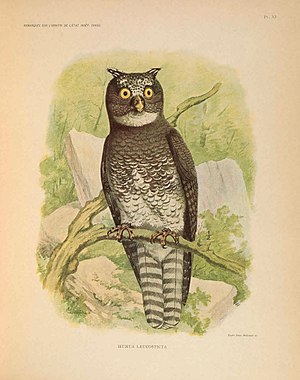Yellow-footed eagle owl
| Yellow-footed eagle owl | ||||||||||
|---|---|---|---|---|---|---|---|---|---|---|

Yellow-footed eagle owl ( Bubo leucostictus ) |
||||||||||
| Systematics | ||||||||||
|
||||||||||
| Scientific name | ||||||||||
| Bubo leucostictus | ||||||||||
| Hartlaub , 1855 |
The yellow-footed eagle owl ( Bubo leucostictus ), also called Käferuhu or Schwachschnabeluhu , is a species from the family of actual owls. It occurs exclusively in West and Central Africa.
features
With a height of 40 to 46 centimeters, the yellow-footed eagle owl is a relatively small species of eagle owl. The top of the body is dark and finely spotted. The feather ears are very noticeable. The eyes are greenish yellow. The underside of the body is pale brown and both spotted and streaked. The claws are relatively weak. Within its range, the yellow-footed eagle owl is the only species that has yellow eyes.
Can be confused with the gray owl . However, this species is very finely spotted on the underside. The Shelley's Eagle-Owl and Verreaux's Eagle-Owl , both of which occur the Gelbfuß-owls in the distribution area, are significantly larger.
distribution and habitat
The yellow-footed eagle owl occurs in West Africa from Guinea, Sierra Leone, Liberia, the Ivory Coast, Ghana and Nigeria to Cameroon and Congo and the northwest of Angola. The species is a resident bird that predominantly inhabits the rainforests of the lowlands. In addition to primary forests, it also occurs in old secondary forests.
Way of life
The yellow-footed eagle owl is active at night and at dawn. It shows the greatest activity on moonlit nights. It mainly transmits in the foliage of large trees and usually sits on branches in the upper treetop. Couples occasionally transmit together. The food spectrum consists mainly of large insects such as beetles, cicadas and cockroaches.
Reproductive biology has not yet been adequately studied. Obviously, however, the time of reproduction varies depending on the location. According to previous knowledge, it often nests on the ground.
supporting documents
Single receipts
literature
- Claus König , Friedhelm Weick: Owls of the World . Christopher Helm, London 2008, ISBN 978-0-7136-6548-2
Web link
- Bubo leucostictus inthe IUCN 2013 Red List of Threatened Species . Listed by: BirdLife International, 2012. Retrieved February 6, 2014.
